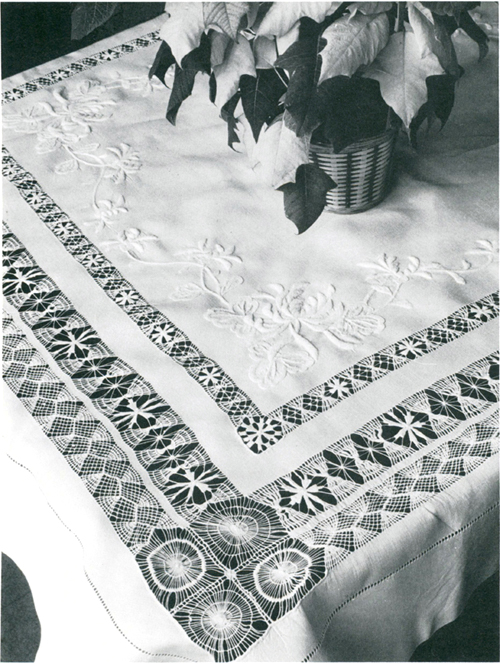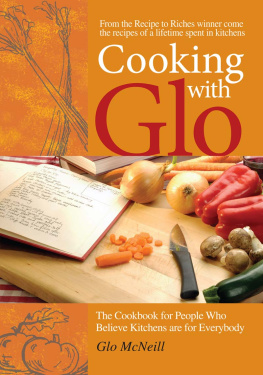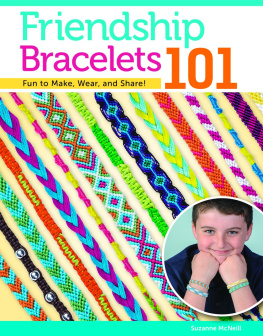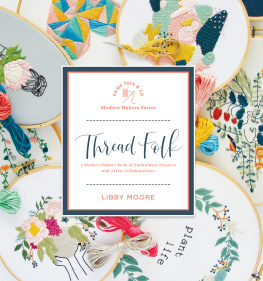Contents
Guide
Drawn Thread Embroidery
Moyra McNeill

An Owl Book
Henry Holt and Company
New York
The author and publisher have provided this e-book to you for your personal use only. You may not make this e-book publicly available in any way. Copyright infringement is against the law. If you believe the copy of this e-book you are reading infringes on the authors copyright, please notify the publisher at: http://us.macmillanusa.com/piracy.

Grandmas teacloth shows well-designed borders with contrasting white surface embroidery in the middle

Introduction

Ah yes, people say when you mention drawn thread, Ive got some tablecloths my grandmother did, and they are very beautiful, but I never use them nowadays except for very special occasions. As with many forms of embroidery, drawn thread still projects an image of a past age, irrelevant to modern life. But used in an evolving, modern way, this type of embroidery offers a wide range of lively possibilities, some of which this book will show. In the coming years of shorter working days and lives, the role of embroidery as a satisfying, creative pursuit can certainly be relevant to current needs.
People are deterred from working embroidery, and drawn thread in particular, for a number of reasons. These can be dealt with one by one.
It looks complicated
Many kinds of embroidery look complicated, but when the stages of production are analysed, most techniques are considerably simpler to work than first sight would suggest.
It looks time-consuming
Embroidery is essentially a slow craft, but nowadays embroiderers have a choice between work that grows quickly and work that is meticulous and time-consuming. By using bold fabrics such as furnishing fabrics and hessian, very effective work can be achieved; also, some machine techniques, worked on the domestic sewing machine, can be based on the concepts of withdrawn thread yet developed in quite a different way to the hand techniques.
It has to be in monochrome
Even monochrome need not be boring if the texture is varied; try contrasting shiny, matt, ridged and knobbly, for example. Variation may also be made between holes or spaces of varied or graded sizes, contrasting with areas of plain fabric.
The fabric can also be coloured; in dress and furnishing fabric departments, materials are displayed in ranges of colour, fibre and scale that are quite suitable for drawn thread. White fabrics may be space-dyed, sprayed or sponged with colour to give interesting lively effects; threads also may be coloured or space-dyed to make the work less mechanical and therefore less boring to do (and certainly less boring for the onlooker).
It is too mechanical
In an embroidery method based on holes, such as drawn thread, the emphasis is on the holes rather than the threads of the fabric; these may be greatly varied in size, and need not be regular; they can be created randomly to make the work livelier.
It is irrelevant to modern needs
Again, people tend to refer to past examples and imagine that drawn thread has a limited range of applications, whereas it can be applied to a considerable range of items in a modern context, from very practical pieces to entirely decorative ones, as this book shows.
It is expensive
This illusion is also based on the premise that drawn thread must be worked on fine Irish linen; it does look very handsome in its traditional form, but nowadays may be translated to more readily available fabrics that are more colourful and bolder in scale. Although natural fibres are enjoyable to work with, many synthetic fabrics are more appropriate if the work is to be laundered. Linen was used in the past simply because it was the indigenous fibre, that is, the most readily available.
Traditional threads are no longer available
It is sad for those of us who have had the pleasure of working with the superb quality of lustrous twisted linen threads to find them no longer freely available; but there are many exciting new yarns on the market which have equal power to inspire and enthuse the embroiderer. These can be synthetic cotton, pure silk, woollen mixtures and even some modern linen threads. Throughout history, embroidery has evolved from century to century, due in a large part to the introduction of new materials and threads from other parts of the world. As with all forms of creativity, if ideas remain fixed and static, embroidery will become stultified and the quality of craftwork will degenerate.
It is so boring to work
Only if the worker allows it to be, by not thinking how to vary stitch, thread, and (therefore) texture to make it interesting to do and look at. Once again, the mental image of yards of identically worked borders impinges on what modern embroidery actually is; as embroiderers today we have a background of centuries of ideas to inspire us, but there is no value in copying them slavishly, as their times were very different from ours.

1 Fabrics and threads

Embroidery aims to alter a fabric or enhance its surface in selected areas, in order to create design, pattern and texture. Drawn thread embroidery, where threads, warp, weft or both, are withdrawn from the fabric, has a long history. Traditionally, the remaining threads are twisted, tied, grouped or woven into other threads in order to make patterns of holes in the fabric.
Drawn fabric looks fragile and lace-like, and so in the past it was thought that removing threads weakened the material, which seems logical. As, however, there are so many drawn thread articles extant from past centuries, it seems this is not the case. For example, many of us have in our care table linen which is now a hundred years or more old, yet has many threads withdrawn. While it would probably be unwise to wash this linen regularly in a washing machine, it has survived boiling, bleaching and the application of indifferent ironing implements, and so must be considerably sturdier than it looks. The material is invariably linen, sewn with linen or cotton threads, and says a lot for the longevity of these fibres. On the other hand, we do not know how many of todays synthetics will react to ageing: it may be that some of them may also have inbuilt longevity. When our ancestors were embroidering it seems unlikely that they were aiming to create for posterity; they simply made what was fashionable at the time, using those materials which were available. Today we sometimes seem obsessed with how long our work will last. Rather, why not do as past ages did that is, work embroidery that is of today, using those fabrics and threads that are available, to express our own creativity and to make articles we want to make.



















